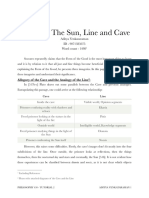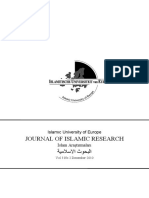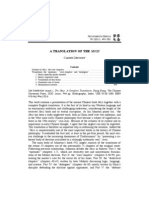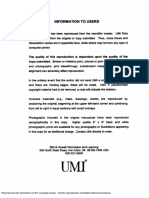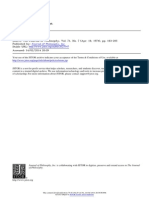Teaching Argumentation From The Nyaya-Sutras - by P.S. Borkowski, PHD
Teaching Argumentation From The Nyaya-Sutras - by P.S. Borkowski, PHD
Uploaded by
BalingkangCopyright:
Available Formats
Teaching Argumentation From The Nyaya-Sutras - by P.S. Borkowski, PHD
Teaching Argumentation From The Nyaya-Sutras - by P.S. Borkowski, PHD
Uploaded by
BalingkangOriginal Description:
Original Title
Copyright
Available Formats
Share this document
Did you find this document useful?
Is this content inappropriate?
Copyright:
Available Formats
Teaching Argumentation From The Nyaya-Sutras - by P.S. Borkowski, PHD
Teaching Argumentation From The Nyaya-Sutras - by P.S. Borkowski, PHD
Uploaded by
BalingkangCopyright:
Available Formats
Teaching argumentation from the Nyaya-Sutras by P.S.
Borkowski, PhD
Posted on November 25, 2012
Abstract It is not possible to cover the entirety of argumentation theory in a single course. This is even more so for professors who are teaching such introductory and general studies requirements on-line (distance-learning) courses. Our goal in this pedagogy, like Gotamas, is practical argument drawn from the theoretical basis of argumentation. This can be extracted from Gotamas Nyaya-Sutras to craft a sequential outline plan for a course in argumentation for social policy (deliberative) arguments. We want to achieve the goal of imparting an holistic view of the subject and provide formal validity, value appeal, and the relevance of the classical traditions. A draft of this article was presented at the Second International Conference on Argumentation and Rhetoric (21-23 September 2012) at Partium Christian University, Oradea, Romania. Theoretical orientation For teaching practical argumentation, the Nyayan syllogism has advantages over the traditional Greek model that is used. Gotama Akapda (which means his meditative habit) is the author of the Nyaya-Sutras and lived around second century BC, although it is argued that the principles of inference expounded in the Nyaya Sutras go back to the time of Panini in the sixth century. The format of the Nyaya-Sutras that we have today was designed by Gangesa around the twelfth century. In addition to teaching the logic of a syllogism, we can extract from this text an introductory model for teaching deliberative arguments. Our project is not for decoration or spice but for presenting a holistic perspective of the theory and practice of argumentation as it always is. Many writing courses are overly familiar to students, so much so that they do not always make the difference between a language class and the distinct subject of argumentation and rhetoric. The Nyaya-Sutras is an example of a text that can raise interest and teach the concepts of argument to todays students. One of the perennial tenets running through all traditions is that (Truth
alone triumphs). In the Nyaya-Sutras, this is the holistic concept of truth as What is, is true, that All what is, is. There is a stable, knowable reality within our three dimensions, five senses, and intellect, and our nearness to understanding it determines
largely how well we discern accurate interpretation and best policy, the preconditions in the classical traditions to progress in both spiritual matters and daily living. This goal is associated with light, and -arg- is the Indo-European root meaning to shine. From this worldview, this general picture of things, argumentation begins on the recognition and admission that there is truth and that best policies are argued on the basis of it. The writers job is to communicate what is best for everybody as opposed to a thesis based on personal agenda or desire. That is, as Richard Weaver expressed it, the difference between teaching rhetoric and argumentation as utiliter loqui (pragmatic speech to close a deal, sell, win) and vere loqui (right speech to communicate the truth, the accurate interpretation, or the best policy). In this context, one of the issues that should be covered early on is that of relativism. The Buddhist doctrine of the two truths can help, for it teaches that there is a common sense truth (samvrtisatya) for daily, concrete perceptions and understandings, and an absolute truth (paramrthasatya) for ultimate reality. It is interesting to remark that the Sanskrit term for relative also implies hidden, false, obstructed. The teacher might point out that English has lost the distinction: relative truth was treowe (trustworthy, sensible) and absolute truth was s. Since social policies of deliberative argument cannot be true or false but instead are practical, fair, efficient, etc, social policy is a matter of what is sensible. Argument is a science of causes (hetu-astra) and a science of inquiry (nvikiki). We want to prevent students from entering argumentation superficially as a fakika-astra or science of sophism. Teaching the fundamental skills of argument provides a way to show the historical and cultural dimension of reasoned debate, and I believe teachers should want to take advantage of this opportunity to do so. We can show how the cognitive process of inference does not change because it is ever-present and constant in humans transculturally across all epochs. Valid reasoning is not devised or constructed by people, it is observed and thus we can learn and teach it, because it exists in the reason of things and has its origin in God (St. Augustine, De doctrina Christiana, 2.32). Logic is identified, the syllogism does not create things but, as the Nyaya-Sutras also teaches, re-aligns things into their proper relationships, which to the minds of this Sanskrit treatise was (is) synonymous with integration or yoga. Indeed, this is the perennial aspect of argumentation as a general science. Nor does logic change with innovations in technology or science or philosophy because it is the very precondition for those innovations. Logic is the same for us today in our lecture halls as it was for the medieval schoolmen in their stone scriptoria, the ancient Greeks beneath their white porticos, the
ancient Aryans in their preceptors hut, and the Talmudic scholars in their courtyard yeshivot. The process of inference The Nyaya defines inference as knowledge that is preceded by perception and gives three basic movements: a) From a perceived effect to an unperceived cause (sesavat, hypothetical reasoning). If Z, then what are the possible causes? X caused Z (alone); X and Y both caused Z (separately); X and Y caused Z (together); X caused Y and Y caused Z (chain); X is present but not related to Z (association). b) From a perceived cause to an unperceived effect (purvavat, consequence). If Z, then what are the possible consequences? c) Co-existence or simultaneity (samanyatodrista, implication). If Z, then what else must also be? According to the Nyaya, the process of inference is always justified, being a kind of innate mechanism. As shown in this passage, the objectors reasoning is correct but not the outcome. If we see a river swollen, we infer that there has been rain; if we see the ants carrying off their eggs, we infer that there will be rain; and if we hear a peacock scream, we infer that clouds are gathering. These inferences, says an objector, are not necessarily correct: a river might be swollen because it is embanked, the ants might carry off their eggs because their nests have been damaged, and the so-called screaming of a peacock might be nothing but the voice of a man. However, the swelling of a river caused by rain is different from that which results from the embankment of a part of it the former comes with great rapids and currents, an abundance of foam, a mass of fruits, leaves, wood, etc. The manner in which ants carry off their eggs just before rain is quite different from the manner in which they do it when their nests are damaged. The ants run away quickly in a steady line when rain is imminent but fear makes them to fly in disorder when their nests are damaged. The screaming of a peacock that suggests gathering clouds is different from a mans imitation of it, for the latter is not natural. If in such cases any wrong inference is drawn, the fault is in the person and not in the process. (NS 2.1.98-99)
That is, the inference-process can be improved but must be already in the person naturally, it is not installed but only sharpened. To develop the three movements, the instructor can design short exercises for each. Present a real or invented question about why something is the way it is, include several hypotheses for students to eliminate in their search for the explanation. Present an observation (event, proposal, natural phenomenon, invention, conflict) and ask students to construct steps to the unperceived effect that it will likely lead to. Present an observation and ask students to identify what else can be inferred to exist that the same time. Teaching logos/syl-logos A list of premises is a set of logoi, but not formally integrated. The Aristotelian contains two premises and a conclusion. Only one premise and a claim is an enthymeme, the missing one being understood or kept in mind, which is what that word means literally. It is such that If the premises are true, and the structure is valid, then the claim must be accepted. When a syllogism contains more than two premises, it is a chain (epikheirema): - Democracy means rule by the people. - For people to be able to rule, they must be informed. - There are no properly informed citizens in a society where there is no free exchange of ideas. - There is no free exchange of ideas without free mass-media. - Therefore, freedom of media is required for a democratic society. (from Richard Weaver) A list of reasons from which the claim must be derived necessarily is simply an enumeration (accumulation): - Institutions like charities exist only through private donations, these generous people provide money that is not otherwise
available. - Charity donations provide tax breaks for the benefactor. - A generous donation is the same amount of money one would spend on a nice dinner. - If we were in their situation, we would want others to help us. - Charity is not a question, it is an obligation of Holy Scripture. - Studies have shown that people who give regularly to charities have lower stress-levels. - Therefore, a person should give to charity. Students see first that these are in fact appeals to advantages and values, that they are reasons (logos), but they are not integrated to derive the claim necessarily (syl-logos). Syllogism in the Nyaya-Sutras Next, students observe the structure of the Aristotelian syllogism and explained what the internal mechanism is that connects the terms. 1. Smoke can be seen on the hill. (middle) (major) 2. Smoke accompanies fire. (middle) (minor) 3. Therefore, theres fire on the hill. (minor) (major) More relevant examples can be designed to illustrate the concept. Should a university require a dress code for students? 1. Students desire (minor) what will train them for their career subjects (middle). 2. The career subjects (middle) studied at university normally require dress codes (major). 3. Students should therefore desire (minor) a dress code (major) at university as part of their training for careers.
The Nyayan syllogism contains five steps (avayava). The first is the proposition QED (pratina); second is the evidence or reason (hetu); third is a general rule (udharana) plus an example (drtnta); fourth is the application of the rule (upanaya); fifth is the conclusion inferred (nigamana). The application in (4) is a formal device but attention to it illustrates the importance of checking that the example is categorically consistent with the term it serves. This is where the advantage is over the Greek syllogism. 1. Theres fire on the hill. 2. Smoke can be seen on the hill. (vyapti) (sdhya) 3. Smoke accompanies fire, like in a hearth. (vyapti) (paka), (drtnta) 4. A hearths fire is smoky. 5. Therefore, theres fire on the hill. (paka) (sdhya) --Proposition: Sound is non-eternal Reason: Because it is produced. General rule: Whatever is produced is non-eternal, +Example: like a pot. Application: So is sound produced. /is categorically similar. Claim: Therefore, sound is non-eternal. We can see that the Greek model is steps 2, 3, and 5 in the Nyayan model. (1) and (5) are identical and we can recall Protagoras words when the Muse tells him There, where I was in the beginning, you will find me at the end (The Way). The advantage of the Nyayan model is the example (drtnta) and the application of the rule (upanaya). This provides contextuality or modality to the syllogism. These bring the logic closer, almost in visual terms, to the audience. Once the statements of the syllogism are completed (sketched out), they may be re-expressed in more idiomatic terms in the prose of a text (essay or speech). Symbolic structure
To illustrate the concept, a sketch can be made of the argument if needed. The teacher will likely spend several class lessons completing exercises in this manner before having students translate them into prose form. The task of sculpting a syllogism into prose without altering the validity of the logic is important. Nyaya Greek Sound is non-eternal 1. S nE 2. S P S P 3. P nE, p P nE 4. S&p P 5. S nE S nE --1. Reading The little prince (R) makes you greatly advantaged (A). 2. Reading this book (R) instructs about understanding human nature (U). 3. Whoever understands human nature (U) is greatly advantaged (A), like one with many years of experience in life (y). 4. Reading The little prince (R) and life experience (y) both teach the same things about understanding human nature (U). 5. Reading The little prince (R) makes you greatly advantaged (A). 1. R A 2. R U R U 3. U A, y U A, y 4. R&y U 5. R A R A --1. Health insurance (HI) cannot be dictated by an employer (~D). 2. Having health insurance (HI) is a personal choice (PC). 3. Personal choice cannot be dictated by another, like the choice whether to commute (cm) to work by public transportation or drive by car. 4. Health insurance and commuting are both personal choices. 5. Health insurance cannot be dictated by an employer.
1. 2. 3. 4. 5.
HI HI PC HI&cm HI
~D PC ~D, cm PC ~D
(4) will often remain unstated in the prose of an essay, but it is useful to check the accuracy of the example/comparison. Quality control for the syllogism The oldest and still most reliable way to check the validity of syllogisms is Aristotles six rules. The Nyaya-Sutras (1.2.5) gives the following syllogistic fallacies: they are more practical because they are the most frequent errors of informal logic. 1. Erratic (savyabhicara, ambiguity) in Aristotle, akin to the fallacy of the four terms. a) two meanings 1. Whatever is in sense experience is material. 2. All knowledge comes from sense experience. C. Therefore all knowledge is material. * Two middle terms (in experience and from experience) b) confusing evaluative and descriptive senses 1. Most people are cheaters, so cheating is natural. 2. What is natural is right. C. Therefore it is right for me to cheat. * The term right is shifted from descriptive in (2) to evaluative in (C). 1. It is just for a man to suffer what he has caused another to suffer, an eye for an eye. 2. What is just is right.
C. Therefore a man who killed should be killed. * In (1) just is evaluative and in (2) it is descriptive. 2. Contradictory (viruddha, contradiction) 3. Equal to the question (prakaranasama, petitio principia) 4. Unproved (sadhyasama, unwarranted assumption) 5. Mistimed (kalatita, irrelevance) Instructors might want to include the fallacy of the Undistributed middle (All As are B; X is B; X is A), however it is not as typical as the other five, being in most instances intuitive. Aristotles fourth and fifth rules concern negative premises and conclusions, also discussed in the Nyaya: A syllogism may not contain two negative premises; If one premise is negative then the claim must be in the negative; If the claim is negative then one premise must be negative. The 5 topics The Nyaya treatise offers four principle topics (, loci) of persuasion to which we will add the syllogism for a total of five topics. Here is the discussion from NS 2.1.126. Persuasion is effected through praise, blame, warning, and prescription. Praise is speech that persuades us to a certain course of action by extolling its (moral, advantageous) consequences, ex: By the Sarvajit sacrifice gods conquered all, there is nothing like Sarvajit, it enables us to obtain anything and vanquish anyone. Here, there is no direct command to perform the sacrifice but the praise is extolled in such a way that we are persuaded that we should do it. Blame is speech that persuades us to adopt a certain course of action by acquainting us with the shameful, undesirable consequences of neglecting it, ex: Anyone who performs a sacrifice neglecting the Jyotitoma falls into a pit and decays there. Here, one is persuaded to perform it because of the very undesirable consequences of not doing so. Warning is the mention of a course of action, the obstruction of which by some person led to bad consequences, ex: On presenting oblation, one is to take the fat first and the sprinkled butter afterwards, but alas! the Caraka priests did it the other way around, which extinguished the fire. Here, the
foolish action of the Caraka priests serves as a warning to others to avoid such action. Prescription implies the commendation of something because of its antiquity. The instructor will cover these in a modern idiom. Falling into a pit and decaying there is not the most effective strategy, however fearsome it might seem. Praise and prescription are fairly clear but the distinction between blame and warning is not. We will interpret them to mean these argument types: 1. Praise 2. Blame 3. Warning 4. Prescription *5. Syllogism Rule of adherence The things that are praiseworthy, disadvantageous, ethically proper, has precedent, and logical are identified in the audience (C. Perelman, The realm of rhetoric). This provides the course instructor with the material needed to introduce points about audience profiling and an audiences values and preferences. It will become clear why Gotama selected these four. Lets take the argument from fear/warning as an example. This strategy attempts to establish that one or several undesirable consequences will follow from not accepting the proposal. The majority of people naturally obey fear, not shame; they avoid what is base because of the penalties and not because it is disgraceful (Aristotle, Nicomachean ethics). The argument from fear is a fallacy only if it cannot be shown that it is real or likely. The writer shows that the fear/threat is so and that the proposal can reduce, delay, or eliminate it. The threat must be real (not one-in-a-million), and tangible (touching the audience directly, not others in a foreign country). There are several occasions when an audience will psychologically minimize or ignore a threat. - Improbable: they do not believe it will really happen. - Remote: it might happen but it will not affect them. Advantage (value) Disadvantage (fear, negative consequence) Principle (propriety, ethical adherence) Precedent (tried-tested-true)
- Unimportant: even if it happens, it wont be so bad. - Distant: other people might be affected but we wont be. Other requirements for constructing the appeal might be included. Examples of points that can be discussed at this point are: The fear must be such that the audience has learned to react to it before. People do not have significant reactions to fears that theyve never encountered and thus do not recognize them. Threats that are too familiar are also not very effective, ex: arguing that government corruption will result if the proposal is not accepted will not be persuasive in a country where this is the normal condition of things. In an argument about avoiding processed foods, the threat of obesity is not going to be worth much because we are all told several times a day in the media that we are overweight. Any suspicion of personal gain must be eliminated from the speaker/writer. An insurance salesman should not use buying insurance as a remedy to avoid the danger. If the danger is not believable, the audience will often reject the writer as being a fearmonger rather than as a source of valuable information. When the solutions given to eliminate or reduce the threat are insufficient (ex: proposing that we should delay any action towards a serious threat until more information comes in), then a surplus anxiety remains and the audience will become insensitive to the threat in the future. Refutation Jati Refutation is defined as reasoning that reveals the character [of your proposal] by showing the absurdity of all contrary characters (NS 1.1.40). Objections to ones proposal must be treated because refuting them has a persuasive character or status. This is really an ethics of intellectual activity: The methodological principle is that it is always best to give the strongest possible interpretation of an argument or a view, particularly if [it] undermines a position that
we currently hold. If our aim is to see our position fully tested, the best way to do that is to meet it head on and answer the strongest objections that could be brought out against it. That is more than to follow the dictum Know your enemies; it is to hold that one should give battle to the strongest forces that can be mustered against oneself, so that the victory will be decisive and not Pyrrhic. Besides, there is always the possibility that we might be wrong and thus that the development of the strongest possible case for a position contrary to ours might make us see where we are mistaken. (Jorge Gracia, Philosophy and its history) Gotama enumerates the perennial forms of refutation in various parts of the NyayaSutras. 1. Wrong in principle: the opposing view violates something which the audience accepts as ethically binding. 2. Undesirable consequences (as above). 3. Reciprocity: the opponents would not wish their view applied to themselves. 4. Hidden agendas: the opposing position is motivated by some personal gain or bias. In Sanskrit this might be in some instances akin to wrangling or cavil. 5. Analogy: the opposing view is like something considered absurd or shameful, impractical, etc. At this point we should mention the tact of granting concessions to opponents. Concessions should be short and not too generous, otherwise they can weaken ones position and then out of a superabundance of fairness, we concede things to our opponent even though they are wicked, false, inept, or dubious (Vico, Instituzioni oratorie). Do not say of any error, It is merely a matter of opinion,for no man indulges an error of judgment, without sooner or later tolerating an error in practice (Charles Spurgeon, Morning & evening). Here is a list that can be incorporated into our project: - The opposing view does not follow logically from the premises given for it; is hypocritical, contains a contradiction. - The opposing view is dangerous.
- The opposing view is not financially advantageous (wasteful). - The opposing view is trying to deceive the audience. - The opponent is biased, promotes a personal agenda or ideology only. - The opponents view will lead to undesirable consequences or an absurd situation. - The opposing view is ethically wrong in principle /or impinges on the rights of others. - The opposing view violates an existing law. - The opposing side proposes something they would not want applied to themselves. - Show that the opponents position was tried before and failed or led to some undesired or embarrassing results. - The opposing view is based on false assumptions or on ignorance of key facts, or fails to notice important distinctions and nuances. - The opposing view is short-sighted, will not work in the long-term. - The opposing view will open more problems. - The opposing view does not get to the source of the problem. Another strategy is to identify what people generally accept and then show that your view is consistent with it. C.S. Lewis was a master of this technique of identification. There are two forms that can be used. a) Something accepted by opponents leads to its own refutation: We know that the body works on a chemical and material cause-effect basis. But this cannot be all of it because such a strict materialism refutes itself: if my mental processes are determined wholly by the motions of atoms in my brain, then I have no basis to suppose that my beliefs are true, and hence I have no basis to suppose my brain to be composed of atoms.
(C.S. Lewis, Miracles) b) Something accepted by opponents leads to your view: Few people would be willing to allow water sewage treatment or garbage collection to be in private hands. We readily agree that police, firefighters, and electricity are public utilities. Parents consider the public school system to be a public utility so that their children can be taken care of while they are at work. Since these things are needed by everybody, and medical treatment is also needed by everybody, even more so, then why are so many afraid to treat medicine as a public utility? (Lev Krotkin, The individual and social process) -Those who claim to care about the well-being of humansshould become vegetarians for that reason alone. They would thereby increase the amount of grain available to feed people elsewhere, reduce pollution, save water and energy, and cease contributing to the clearing of forestsWhen non-vegetarians say that human problems come first, I wonder what exactly it is that they are doing for human beings that compels them to continue to support the wasteful, ruthless exploitation of farm animals. (Peter Singer, Animal liberation) Pedagogical model It is not possible to cover the entirety of argumentation theory in a single course. This is even more so for teachers who are doing on-line (distance-learning) courses. Our goal, like Gotamas, is practical argument. From the above discussion, we have a sequential outline plan for a course in argumentative writing: 1- STATEMENT OF PROBLEM 2- DESCRIPTION, CONNECT READERS TO THE PROBLEM 3- THE 5 TOPICS a) The argument from perceived advantage or value b) The argument from disadvantage;
c) The argument from principle d) The argument from precedent e) The argument from syllogism 4- REFUTATIONS 5- CLOSING Steps 3 and 4 are interchangeable, of course. Exercises can be easily designed for each step. And all of the steps will fit nicely together for longer essay tasks. Thus, the goal of imparting an holistic view of the subject and providing formal validity, value appeal, and the relevance of the classical traditions are accomplished. Source The sacred books of the Hindus, vol.8: NYAYA SUTRAS OF GOTAMA. Edited by B.D. Basu. Sudhindranatha Vasu, Bahadurganj, India 1913.
You might also like
- Tithenai Ta PhainomenaDocument16 pagesTithenai Ta PhainomenaGanimedes999No ratings yet
- THE SUN LINE AND CAVE PlatoDocument5 pagesTHE SUN LINE AND CAVE PlatoNefen KukiNo ratings yet
- Armstrong1974 Infinite Regress Argument and The Problem of UniversalsDocument13 pagesArmstrong1974 Infinite Regress Argument and The Problem of UniversalsFábbio CerezoliNo ratings yet
- The Early Buddhist Theory of Man Perfected - Horner Isaline B. (1936) PDFDocument325 pagesThe Early Buddhist Theory of Man Perfected - Horner Isaline B. (1936) PDF101176No ratings yet
- Kriya-Yoga - Yoga-SutraDocument10 pagesKriya-Yoga - Yoga-SutraBalingkangNo ratings yet
- Epicurus - All Sensations Are TrueDocument15 pagesEpicurus - All Sensations Are TrueLeandro FreitasNo ratings yet
- Graham Two Dialogues in The Kungsun Lung TzuDocument9 pagesGraham Two Dialogues in The Kungsun Lung TzuHaeook JeongNo ratings yet
- Ghazali's Account of Signification PDFDocument18 pagesGhazali's Account of Signification PDFproklos100% (1)
- WadaDocument12 pagesWadaitineo2012No ratings yet
- Jullien - 'Did Philosophers Have To Become Fixated On Truth'Document22 pagesJullien - 'Did Philosophers Have To Become Fixated On Truth'Kam Ho M. WongNo ratings yet
- Clarke, 1981. Homer's Readers A Historical Introduction To The Iliad and The Odyssey, Newark, 60-105.Document5 pagesClarke, 1981. Homer's Readers A Historical Introduction To The Iliad and The Odyssey, Newark, 60-105.PerseusAusKitiumNo ratings yet
- Carine Defoort - A Translation of The MoziDocument11 pagesCarine Defoort - A Translation of The MozinqngestionNo ratings yet
- The Philosophy of Spinoza (Volume 1)Document468 pagesThe Philosophy of Spinoza (Volume 1)Alexandre De Pomposo García-CohenNo ratings yet
- Brentano and His Scholastical RootsDocument10 pagesBrentano and His Scholastical RootstorrcastrNo ratings yet
- Prosodic Words: Sharon PeperkampDocument6 pagesProsodic Words: Sharon PeperkampTwana1No ratings yet
- The Divinizing of Matter Some ReflectionDocument12 pagesThe Divinizing of Matter Some ReflectionaeubuleuNo ratings yet
- Nagatomo - Logic of Diamond-SūtraDocument13 pagesNagatomo - Logic of Diamond-SūtraMigellangoNo ratings yet
- Essays in Jaina Philosophy and Religion, Ed Piotr BalcerowiczDocument320 pagesEssays in Jaina Philosophy and Religion, Ed Piotr BalcerowiczszalerpNo ratings yet
- Topoi Volume 5 Issue 2 1986 (Doi 10.1007/bf00139229) Izchak Miller - Husserl On The EgoDocument6 pagesTopoi Volume 5 Issue 2 1986 (Doi 10.1007/bf00139229) Izchak Miller - Husserl On The Egodagnasty85No ratings yet
- History - Medieval and Renaissance Philosophy of MindDocument6 pagesHistory - Medieval and Renaissance Philosophy of Mindgauchofiero99No ratings yet
- Deely 2006 - Semiotics As Naming The Doctrine of Signs-LibreDocument31 pagesDeely 2006 - Semiotics As Naming The Doctrine of Signs-LibreKahfie NazaruddinNo ratings yet
- (Cheff) Study of Philosophy in Early Periode of IslamDocument7 pages(Cheff) Study of Philosophy in Early Periode of IslamCheff IglesiasNo ratings yet
- Reading The Proemium of Plato's: Theaetetus: Euclides in ActionDocument28 pagesReading The Proemium of Plato's: Theaetetus: Euclides in ActionCatalina MárquezNo ratings yet
- Pythagoras, The Cult of ApolloDocument64 pagesPythagoras, The Cult of Apollorobertseasterling100% (1)
- Porphyry Isagogue PDFDocument59 pagesPorphyry Isagogue PDFphilip shtern100% (1)
- Suarez On The Reduction of Categorical RelationsDocument24 pagesSuarez On The Reduction of Categorical RelationsGabriel de AlmeidaNo ratings yet
- Alcuin of York Commentary On Revelation PDFDocument136 pagesAlcuin of York Commentary On Revelation PDFJon Paul MartinezNo ratings yet
- Devitt Singular Terms PDFDocument24 pagesDevitt Singular Terms PDFJohn ChristmannNo ratings yet
- The Penguinification of Plato Trevor SaundersDocument11 pagesThe Penguinification of Plato Trevor SaundersabunasrNo ratings yet
- Platonism and Neoplatonism The Oxford EDocument9 pagesPlatonism and Neoplatonism The Oxford ElistboxNo ratings yet
- Robbe Vita Aristotelis Ex Codice MarcianoDocument83 pagesRobbe Vita Aristotelis Ex Codice MarcianoalverlinNo ratings yet
- Kokoro 5 Tola DragonettiDocument38 pagesKokoro 5 Tola Dragonettishiv161No ratings yet
- Hutchinson, D.S. Ransome Johnson, Monte (Eds.) - Aristotle Protrepticus or Exhortation To Philosophy PDFDocument91 pagesHutchinson, D.S. Ransome Johnson, Monte (Eds.) - Aristotle Protrepticus or Exhortation To Philosophy PDFLuiz BruderNo ratings yet
- GuodianDocument34 pagesGuodianllywiwr100% (1)
- Rhetoric and PhilosophyDocument12 pagesRhetoric and PhilosophymarkmrakovcicNo ratings yet
- Greek Scepticism Anti Realist Trends in Ancient Thought 1990Document210 pagesGreek Scepticism Anti Realist Trends in Ancient Thought 1990pitigriliNo ratings yet
- Piotr Hoffmann (Auth.) - The Anatomy of Idealism - Passivity and Activity in Kant, Hegel and MarxDocument126 pagesPiotr Hoffmann (Auth.) - The Anatomy of Idealism - Passivity and Activity in Kant, Hegel and MarxluizNo ratings yet
- Greek Philosophical Terms PDFDocument4 pagesGreek Philosophical Terms PDFJennifer LeQuireNo ratings yet
- Tavadia - RtaDocument9 pagesTavadia - Rtadanishhamid2010No ratings yet
- Bondeson - Some Problems About Being and Predication in Plato S Sophist 242-249Document11 pagesBondeson - Some Problems About Being and Predication in Plato S Sophist 242-249FélixFernándezPalacioNo ratings yet
- 3110222922Document205 pages3110222922aemerloNo ratings yet
- Descartes, Kant and Self Consciousness (Priest, 1981) PDFDocument5 pagesDescartes, Kant and Self Consciousness (Priest, 1981) PDFUjueticaNo ratings yet
- Cadden2012 Albertus Magnus On Vacua in The Living Body PDFDocument18 pagesCadden2012 Albertus Magnus On Vacua in The Living Body PDFEsotericist MaiorNo ratings yet
- The Cosmotheology of de Mundo in Ps. AristotleDocument14 pagesThe Cosmotheology of de Mundo in Ps. AristotleVicente GarridoNo ratings yet
- 7Document19 pages7EDOH ODUM100% (1)
- Diogenes of Sinope As Socrates MainomenosDocument27 pagesDiogenes of Sinope As Socrates MainomenosCarlosAscheNo ratings yet
- By Ben Van Wyke: Translation and EthicsDocument2 pagesBy Ben Van Wyke: Translation and EthicsAlexNo ratings yet
- Aristocles On TimonDocument20 pagesAristocles On TimonSamuel Burns100% (1)
- The Reception of Aristotles Categories C 80 BC To AD 220-1Document504 pagesThe Reception of Aristotles Categories C 80 BC To AD 220-1AveNo ratings yet
- Allegoryinstoicismandplatonism PDFDocument37 pagesAllegoryinstoicismandplatonism PDFanon_243369186No ratings yet
- Les Conceptions de 00 Del ADocument48 pagesLes Conceptions de 00 Del AGelu Diaconu100% (1)
- From Stoicism To Platonism (The Development of Philosophy, 100 BCE-100 CE) Are We Nearly There Yet Eudorus On Aristotle's CategoriesDocument13 pagesFrom Stoicism To Platonism (The Development of Philosophy, 100 BCE-100 CE) Are We Nearly There Yet Eudorus On Aristotle's Categoriesmusic cisumNo ratings yet
- Nizkor Project Fallacies - LabossierDocument77 pagesNizkor Project Fallacies - Labossierapi-3766098100% (1)
- The Categories and The Status of The PHDocument16 pagesThe Categories and The Status of The PHAllen AndersonNo ratings yet
- PhA 113 - Eliasson - The Notion of That Which Depends On Us in Plotinus and Its Background PDFDocument265 pagesPhA 113 - Eliasson - The Notion of That Which Depends On Us in Plotinus and Its Background PDFPhilosophvs AntiqvvsNo ratings yet
- Thabit Ibn Qurra and The Pythagorean TheoremDocument11 pagesThabit Ibn Qurra and The Pythagorean TheoremMuhammad Amin SayfullaevNo ratings yet
- L. Campbell - On The Place of The Parmenides in The Chronological Order of The Platonic DialoguesDocument9 pagesL. Campbell - On The Place of The Parmenides in The Chronological Order of The Platonic DialoguesRashi BennettNo ratings yet
- The Eudemian and Nicomachean Ethics: A Study in the Development of Aristotle's ThoughtFrom EverandThe Eudemian and Nicomachean Ethics: A Study in the Development of Aristotle's ThoughtNo ratings yet
- Life and Matter: A Criticism of Professor Haeckel's "Riddle of the Universe"From EverandLife and Matter: A Criticism of Professor Haeckel's "Riddle of the Universe"Rating: 4 out of 5 stars4/5 (1)
- VratisasanaDocument20 pagesVratisasanaBalingkangNo ratings yet
- The Path of Atīśa Dīpaïkara Śrījñāna (982 - 1054 CE) (Borderless Prajñā and Compassion)Document3 pagesThe Path of Atīśa Dīpaïkara Śrījñāna (982 - 1054 CE) (Borderless Prajñā and Compassion)BalingkangNo ratings yet
- Agastya StavaDocument8 pagesAgastya StavaBalingkangNo ratings yet
- BUTAKALA - M. Stephen - Returning To Original Form A Central Dynamic in Balinese Ritual PDFDocument35 pagesBUTAKALA - M. Stephen - Returning To Original Form A Central Dynamic in Balinese Ritual PDFBalingkangNo ratings yet
- Prasasti Batu JimbarDocument8 pagesPrasasti Batu JimbarBalingkangNo ratings yet
- Arga Patra - Tingkahing Weda ParikramaDocument23 pagesArga Patra - Tingkahing Weda ParikramaBalingkang67% (3)
- Living Balinese Heritage: Palm-Leaf Manuscripts and Their CaretakersDocument1 pageLiving Balinese Heritage: Palm-Leaf Manuscripts and Their CaretakersBalingkangNo ratings yet
- The Open Ends of The Ducth Empire and The Indonesian PastDocument26 pagesThe Open Ends of The Ducth Empire and The Indonesian PastBalingkangNo ratings yet
- The Tathagatagarbha Sutra: Siddhartha's Teaching On Buddha-NatureDocument6 pagesThe Tathagatagarbha Sutra: Siddhartha's Teaching On Buddha-NatureBalingkangNo ratings yet
- Theory of NyayaDocument8 pagesTheory of NyayaBalingkangNo ratings yet
- Teaching Argumentation From The Nyaya-Sutras - by P.S. Borkowski, PHDDocument15 pagesTeaching Argumentation From The Nyaya-Sutras - by P.S. Borkowski, PHDBalingkangNo ratings yet
- Agama and NigamaDocument4 pagesAgama and NigamaBalingkangNo ratings yet
- JED Ecotourism Organisations and ResourcesDocument1 pageJED Ecotourism Organisations and ResourcesBalingkangNo ratings yet
- Decolonizing The Indian Mind - KAPIL KAPOORDocument10 pagesDecolonizing The Indian Mind - KAPIL KAPOORBalingkangNo ratings yet
- Adi-Buddha - Adibuddha: in Memory of Bhikkhu Ashin Jinarakkhita Mahasthavira - Bunki KimuraDocument20 pagesAdi-Buddha - Adibuddha: in Memory of Bhikkhu Ashin Jinarakkhita Mahasthavira - Bunki KimuraBalingkangNo ratings yet
- The Figurative Simile Theory - William G. LycanDocument5 pagesThe Figurative Simile Theory - William G. LycanBalingkangNo ratings yet
- Select Bibliography of Upamana PramanaDocument7 pagesSelect Bibliography of Upamana PramanaBalingkangNo ratings yet
- The Sanskritization of Jawa and The Javanization of The Bharata by S. SupomoDocument24 pagesThe Sanskritization of Jawa and The Javanization of The Bharata by S. SupomoBalingkangNo ratings yet
- Alamkara-Contribution To Poetics and Dramaturgy-Sures Chandra BanerjiDocument23 pagesAlamkara-Contribution To Poetics and Dramaturgy-Sures Chandra BanerjiBalingkang100% (1)
- Silsilah Raja Jawa-Bali-Prabhu Déwata Cěngkar Ring Mědang KamulanDocument3 pagesSilsilah Raja Jawa-Bali-Prabhu Déwata Cěngkar Ring Mědang KamulanBalingkangNo ratings yet

